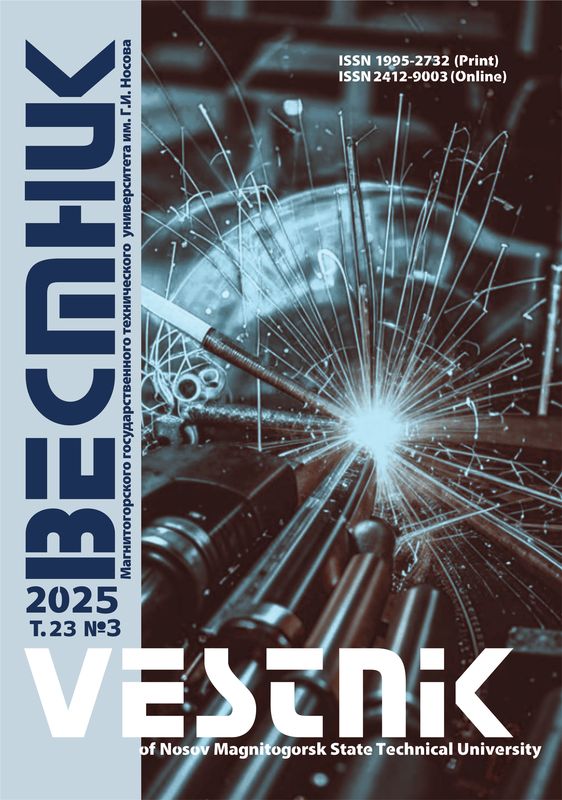DOI: 10.18503/1995-2732-2020-18-4-39-47
Abstract
Ensuring a high quality of products and efficient production involves the use of modern, advanced equipment. This is of particular importance for precision of finishing machining, prominently represented by a grinding operation. Grinding is a main method of finishing of hardened parts. A significant share of grinding operations are cylindrical plunge grinding. Machining performance depends on the cutting conditions set depending on the steel grade of the workpiece and the requirements for accuracy of the finished part. Replacing old machines with new ones leads to the need to revise the regulatory documents. Therefore, the development of a new automated, highly efficient method for calculating cylindrical grinding cycles is more urgent than ever for the machine building industry. To develop a new method, the authors analyzed the current situation, determined the main limitations due to the radial feed, and developed the mathematical models to implement these limitations. The developed method of designing high-performance cylindrical plunge grinding cycles makes it possible to determine a reasonable number of cycle stages and relevant modes. When designing a grinding cycle, the following parameters are taken into account: material and size of the machined workpiece surface, surface requirements, characteristics of the grinding wheel and the machine. This method contributes to machining at the highest performance cutting modes, while complying with the set process limitations. The cycles calculated according to the developed method are 30% more efficient than those calculated according to general machine-building standards. In the future, this method of designing cycles will become the basis for developing a software module for designing cylindrical plunge grinding cycles on CNC machines.
Keywords
Grinding, machining cycles, method of designing.
For citation
Degtyareva-Kashutina A.S., Dyakonov A.A. Method of Designing Highly Efficient Cycles of Cylindrical Plunge Grinding. Vestnik Magnitogorskogo Gosudarstvennogo Tekhnicheskogo Universiteta im. G.I. Nosova [Vestnik of Nosov Magnitogorsk State Technical University]. 2020, vol. 18, no. 4, pp. 39–47. https://doi.org/10.18503/1995-2732-2020-18-4-39-47
1. Pereverzev P.P. et al. Obshchemashinostroitelnye normativy vremeni i rezhimov rezaniya dlya normirovaniya rabot, vypolnyayemykh na universalnykh i mnogotselevykh stankakh s chislovym programmnym upravleniyem: spravochnik. [General machine-building standards for time and cutting modes for standardizing work performed on universal and multi-purpose computer numerical control machines: a reference book]. Moscow: Economics, 1990, 394 p. (In Russ.)
2. Vereina L.I., Krasnov M.M., Fradkin E.I. Abrazivnaya obrabotka: spravochnik [Abrasive processing: a handbook] Moscow: INFRA-M, 2017, 304 p. (In Russ.)
3. Pereverzev P.P. Teoriya i metodika rascheta optimalnykh tsiklov obrabotki detaley na krugloshlifovalnykh stankakh s programmnym upravleniyem: avtoreferat dis. dokt. tekhn. nauk [Theory and methodology for calculating the optimal processing cycles of parts on computer controlled circular grinding machines: Extended abstract of the doctoral thesis]. Chelyabinsk, 1999, 36 p.
4. Pereverzev P.P, Akintseva A.V. Modeling of metal removal during an internal grinding in view of kinematics cutting features. Russian Engineering Research 36, 10, 888–893 (2016).
5. Pereverzev P.P., Akintseva A.V., Alsigar M.K. Application of the digital twin in predicting the reliability of control programs for CNC machines. Innovatsii v mashinostroenii [Innovations in Mechanical Engineering], 2018, pp. 228–232. (In Russ.)
6. Nurkenov A.Kh. Design of multi-stage cylindrical plunge grinding cycles for CNC machines. Naukoemkie tekhnologii na sovremennom etape razvitiya mashinostroeniya [Science-intensive technologies at the present stage of mechanical engineering development], 2016, pp. 151–153. (In Russ.)
7. Lee C.W. A control-oriented model for the cylindrical grinding process. The International Journal of Advanced Manufacturing Technology, 44, 7–8, 657–666 (2009).
8. Shen Nanyan, He Yongyi, Li Jing, Fang Minglun. An improved differential evolution (IDE) based on double populations for cylindrical grinding optimization. 2009 International Conference on Measuring Technology and Mechatronics Automation, IEEE Xplore, 10835217 (2009) DOI: 10.1109/ICMTMA.2009.370
9. Changsheng Guo, Yan Chen. Thermal modeling and optimization of interrupted grinding. CIRP Annals. 67, 1, 321–324 (2018). https://doi.org/10.1016/j.cirp.2018.04.083
10. Radovan Dražumerič, Roope Roininen, Jeffrey Badger, Peter Krajnik. Temperature-based method for determination of feed increments in crankshaft grinding. Journal of Materials Processing Technology, 259, 228–234 (2018).
11. Korchak S.N. Proizvoditelnost protsessa shlifovaniya stalnykh detaley [Steel parts grinding performance]. Moscow: Mechanical Engineering, 1974, 280 p. (In Russ.)
12. Klochko V.I. Effektivnost vysokoskorostnogo shlifovaniya raznykh staley i splavov s uchetom tochnosti i kachestva obrabotki: dis. … kand. tekhn. nauk [The efficiency of high-speed grinding of different steels and alloys, taking into account the accuracy and quality of processing: Ph.D. dissertation]. Chelyabinsk, 1984, 207 p.
13. Shipulin L.V., D'yakonov A.A. Imitation model of forecasting surface relief when forming it during cylindrical grinding. Procedia Engineering, 936–941 (2016).












